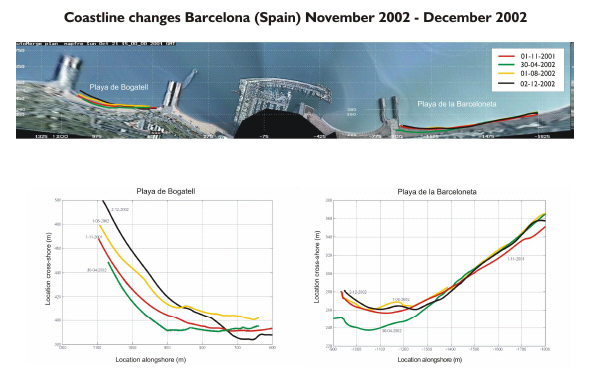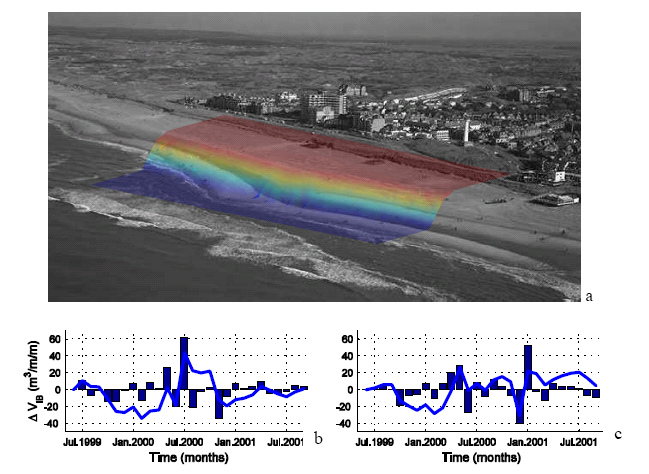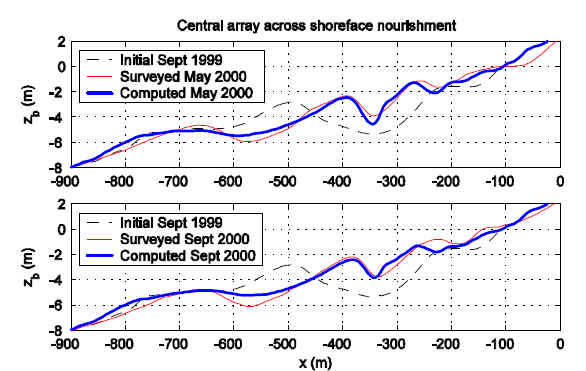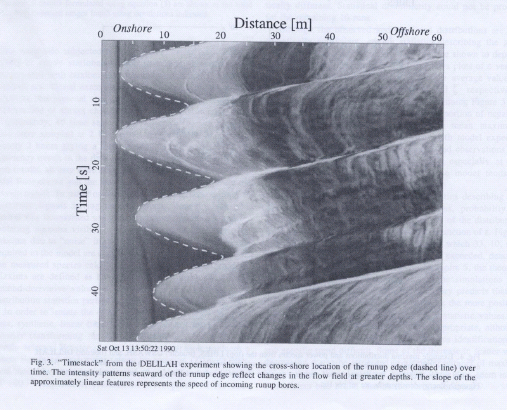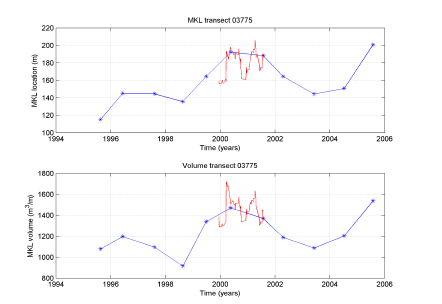Argus applications
This article describes five applications which can be used to quantify coastal state information, based on data collected with an Argus video monitoring system. For definitions of used terminology, see also definitions of coastal terms.
Contents
- 1 Introduction
- 2 Quantification of storm-driven shoreline changes
- 3 Intertidal morphological changes at a nourished beach
- 4 Measurement of surf zone bathymetry
- 5 Quantification of wave run-up on coastal structures
- 6 Beach Wizard, assimilation of model computations and video observations
- 7 See also
- 8 References
Introduction
Successful use of video monitoring techniques in support of coastal management and engineering involves the quantification of relevant coastal state information from video data. Sophisticated, operational video analysis methods nowadays enable the quantification of:
- Shoreline evolution and beach width, to evaluate the potential for recreation or to assess the morphological impact of a storm event
- Erosional and accretional sediment volumes at the intertidal beach. For example to evaluate the morphological impact of coastal structures, to investigate seasonal fluctuations in beach dynamics and beach nourishments or to study the behaviour of morphological features such as sand spits and tidal flats near a harbour entrance
- Subtidal beach bathymetry, to evaluate coastal safety, to assess the behaviour and performance of shoreface nourishments or even to facilitate military operations
- Wave run-up, to evaluate the stability of coastal structures such as seawalls, harbour moles and revetments
- Coastal State Indicators with a high resolution in time through assimilation of model computations with Argus observations
In a research context, video monitoring techniques have been applied to quantify alongshore flow velocities, wave characteristics such as wave angle and period, the occurrence of algae bloom and the distribution and persistence of rip currents. Future applications may involve the monitoring of visitor density at the beach and the prediction of rip currents.
The continuous collection of long-term, high-resolution data sets carries the additional advantage of a posteriori data selection including the consistent assessment of storm damage to public and private property and the early recognition of important erosion trends.
Quantification of storm-driven shoreline changes
In Barcelona ,Spain, a shoreline detection model is used to assess storm-driven shoreline changes in front of Puerto Olimpico. The model derives the location of the shoreline from time exposure images taken on the basis of the colour contrast between the dry and wet beach (Aarninkhof et al, 2003[1]). Detailed observations show a shoreline retreat up to tens of metres during a single storm event.
Intertidal morphological changes at a nourished beach
In Egmond ,Netherlands, intertidal beach bathymetries are determined on a monthly basis by mapping a series of video-derived shorelines at different water levels throughout a tidal cycle (see also Figure 2). The mean vertical offset of this model is less than 15 cm along 85% of the 2 km wide study region. The resulting bathymetries (Figure 2a) are used to quantify patterns of erosion and accretion after combined beach and shoreface nourishment. Example results are presented in the graphs (Figure 2b and 2c), which show means of the monthly volume changes per meter coastline (bars), as well as the cumulative morphological changes (lines). Negative values denote erosion. Figure 2b presents the volume changes at a location 400 m to the South of the Argus station; figure 2c presents volume changes at a location 400 m to the North of the station. The analysis shows a tendency toward erosion during the first year. High-resolution video monitoring indicated that the additional beach nourishment implemented in the left-hand section (Figure 2b) in July 2000 disappears from the intertidal beach within a few months.
Measurement of surf zone bathymetry
In Egmond ,Netherlands, Argus video imagery has been used to monitor the evolution of surf zone bathymetry after implementation of the shoreface nourishment in July of 1999 (see Figure 3). The bed elevation is continuously updated on the basis of a comparison between video-derived and model-computed patterns of wave dissipation (Aarninkhof, 2003,[1]). This approach yields marginal deviations in the order of 10 to 20 cm at the seaward face of the bars, which increase up to 20 to 40 cm near the bar crest. The results show a shoreward migration of the outer bar after deployment of the shoreface nourishment as well as a net accretion of sediment along the shallow part of the beach profile above the 2 m depth contour, thus confirming the beneficial impact of the nourishment.
Quantification of wave run-up on coastal structures
Wave run-up and wave overtopping are two of the mechanisms that may cause damage to, or even failure of, coastal structures such as seawalls, harbour moles and groins (see also hard coastal protection structures). High frequency video observations (typically at 2 Hz) can be used to determine the statistics of wave run-up at beaches and coastal structures. The figure above shows an example of a timestack image, in which pixel intensities are sampled along a cross-shore array in the swash zone and stacked over time. The position of the swash edge can be visually identified by the sharp change in intensity between the darker beach surface and the lighter ‘foamy’ edge of the swash bore (Holland and Holman, 1993,[2]). This type of monitoring yields information on the wave attack at structures during a single storm event or throughout the whole year. Formulas for wave runup on coastal structures and wave overtopping can be found in Eurotop (2018), an overtopping manual largely based on European research, but for worldwide application [3].
Beach Wizard, assimilation of model computations and video observations
The Beach Wizard model involves sophisticated use of high-resolution video observations in combination with a 2DH morphological model. This opens the door toward the nowcasting of near-shore hydrodynamics and bathymetric evolution with a high resolution in time and space. The Beach Wizard approach involves the application of a morphological area model to compute nearshore wave propagation and flow circulation patterns.A key-element of the model is the updating of bathymetry on the basis of high-resolution Argus video observations of the surf zone. This is achieved through assimilation of video-observed and model-predicted patterns of wave dissipation, wave celerity and intertidal beach bathymetry. Confidence intervals are determined for each bathymetry estimate, to enable a weighed assimilation of the different data sources and the model. Given the high resolution of video observations in time, this approach allows for virtually continuous monitoring of the evolution of surf zone bathymetry.
The technique has been applied to a synthetic case and two field sites at Duck, NC ,USA, and Egmond , Netherlands. The model is validated for a synthetic case which shows that the assimilation scheme is capable of recovering a barred beach bathymetry starting from an initially plane beach and only “knowing” the dissipation rate and celerity fields. The application to the Duck case shows that over a short time span (including one major storm event) the model is capable of predicting the bathymetry rather accurately given a sequence of remotely observed inputs. The model is then applied to the long-term case of Egmond. Here, the model is also capable of predicting the profile change with the same parameter settings as in the Duck case. The agreement is better for the winter months with stronger observed signals than in the summer months.
The model output is used to estimate Coastal State Indicators. The intra-annual behavior shows a large variability which is on the order of the long-term (decadal) variation that is captured by the annual ground-truth surveys. While the net sum gain or loss over an alongshore area is smaller than the variation over an individual cross-section, the fact that beaches are very active over short timescales may have consequences for coastal management.
See also
Internal links
- Argus video monitoring system
- Argus standard image processing
- Argus image types and conventions
- Video technology
- Swash zone dynamics
References
- ↑ 1.0 1.1 Aarninkhof, S.G.J. (2003). Nearshore bathymetry derived from video imagery. PhD. Thesis, Delft University of Technology, 175 pp
- ↑ Holland, K.T. and Holman, R.A. (1993). The statistical distribution of swash maxima on natural beaches. Journal of Geophysical Research, 98, pp. 10271-10278.
- ↑ Van der Meer, J.W., Allsop, N.W.H., Bruce, T., De Rouck, J., Kortenhaus, A., Pullen, T., Schüttrumpf, H., Troch, P. and Zanuttigh, B. 2018. EurOtop, 2018. Manual on wave overtopping of sea defences and related structures. www.overtopping-manual.com
Please note that others may also have edited the contents of this article.
|
Please note that others may also have edited the contents of this article.
|
